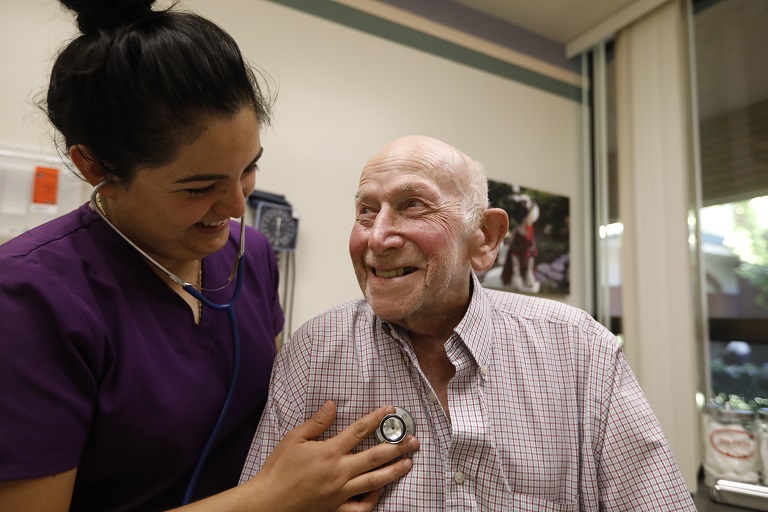How Telehealth Can Address Staff Shortages
Telehealth has the power to transform care at home and in facilities by leveraging the workforce, said experts at the recent Collaborative Care Tech Summit. “Can Telehealth Address Shortage of Clinicians & Caregivers?” offered ways to encourage telehealth adoption among workers and ways to advocate for telehealth.
The 2022 Summit, hosted by LeadingAge and the LTPAC Health IT Collaborative, took place online June 7-8, 2022. You may still see the program and purchase on-demand access to content. HealthJay, an Associate Business Partner with CAST Focus, sponsored the telehealth session. Consider also attending an upcoming webinar on telehealth and RPM in practice on July 21, 2022, from 2 p.m. – 3:30 p.m. ET.
Telehealth to Transform Care by Leveraging Staff
Telehealth is “going to redefine home care,” said Ornit Niv, COO of BrightStar Care® of the Upper East Side and BrightStar® of South Brooklyn, a home health agency. Prior to telehealth, home care was highly inefficient in terms of seeing patients. Now, staff can see more clients more often and become more engaged with them.
Gerard Moawad, M.D., agreed that for physicians in the post-acute care world, telehealth is a big add-on. Moawad is CEO of M-Medical Group, which provides post-acute care coverage. Telehealth gives patients quick access to healthcare providers nearly 24 hours a day without needing to leave their facility, and it minimizes the time that physicians previously lost to driving. “It’s a huge moment in the industry to have that kind of capability, to have telehealth touching all these patients,” Moawad said.
Increasing Staff Adoption
To provide the most benefits, said one panelist, prepare workers to use telehealth. “Therapy delivered via telehealth is a specialty and we treat it that way, with specialized training and preparation for all of our clinicians before they ever start providing telehealth,” said Mike Billings, PT, DHSc, MS, CEEAA, chief strategy and business development officer of Infinity Rehab.
Billings cautioned that clinicians may perceive telehealth as an added burden to their day, as they deal with technology challenges, added patient consent and ID procedures, and learning how to work through the presenter at the original site. These elements can improve or exacerbate staffing challenges.
To build provider or clinician satisfaction, create a systematic approach to guide the telehealth program, including outcomes tracking, human factors, clinical factors, ethical factors, technology and administration guidelines. Factor in patient workflow for people to serve as presenters. Spell out everything clearly and offer training. These steps will help increase staff acceptance of telehealth, Billings said.
At first, Niv’s organization introduced telehealth to skilled care physical therapists. They were very receptive, as telehealth was more efficient than traveling to patient homes and did not expose them to COVID.
However, home health aides were not receptive, as they needed to facilitate with a camera and found the technology complicated. In addition, patients were less likely to follow through with physical therapy exercises through telehealth. Niv had to break down the technology barriers to make interactions seem more real. She did so by using a better technology platform, HealthJay, which brought down defensiveness from clients and aides.
Advocacy—What Is Next?
Moderator Robert Latz, PT, DPT, CHCIO, CIO of Trinity Rehab Services, asked speakers to share what they think is needed to advocate for telehealth.
1) Address the Business Side of Telehealth: Moawad noted that while Medicare does not reimburse physician groups or nursing homes for telehealth costs, telehealth decreases hospital readmissions and 911 calls by 50% and cuts the need for county resources such as ambulances. These reduced costs far outweigh the additional spending, he said.
However, reimbursement remains a challenge that must be addressed, said Moawad. And giving physicians using telehealth a better way to practice in a different state could make a difference. “We should not suffocate the technology; we should embrace it. We should make more guidelines to it.”
Two years of data show a difference in cost savings, more patients being treated in nursing homes, better outcomes, and not using resources of bouncing from skilled nursing facilities to the hospital and back, Moawad said.
Telehealth “does create the potential for more patient interaction, but it doesn’t necessarily mean that it’s more cost to the system,” said Billings. “I think we need to study that, because more frequent contact with our patients is a good thing.”
2) Make telehealth accessible to older adults at home. Niv spoke of clients who are afraid to go outside and do not have someone to take them to doctors’ offices. Telehealth can help clients make lifestyle changes that reduce the risk of developing Alzheimer’s disease, heart disease, etc. Telehealth can also enable regular client assessments that prevent health challenges and provide early detection, to improve health outcomes and reduce costs. “This is where the big change for us is coming,” she said.
Yet technology needs to conform to usability to the end user, said Niv, citing sensors on pill boxes and refrigerator doors. Simple technology could even facilitate a drop-in visit with a doctor.
Missed this Session?
If you have missed this session, you can view it, along with the other Summit keynotes and sessions, on-demand by visiting the Summit event page.
Finally, if you’re interested in the application of telehealth in different care settings, attend the LeadingAge Learning Hub webinar “Telehealth in Practice: Driving Efficiencies & Improving Outcomes,” to be held July 21, 2022, from 2 p.m. to 3:30 p.m. ET.

Most Recommended
October 15, 2025
 Shutdown Week Three: Impact of Ongoing Closure on Affordable Housing
Shutdown Week Three: Impact of Ongoing Closure on Affordable Housing
December 10, 2025
Fiscal Year (FY) Funding 2026
October 07, 2025
Immigrant Workforce Matching Program Brings Workforce Relief
Recently Added
December 19, 2025
House Moves Forward on Affordable Housing Reforms
December 19, 2025
White House Cannabis EO Paves Way for Research, Access
December 19, 2025
LeadingAge Urges DHS to Maintain "Public Charge" Guardrails
December 18, 2025



